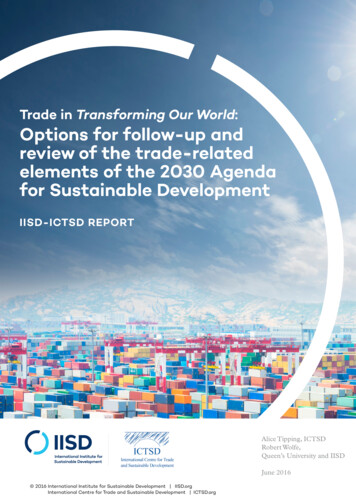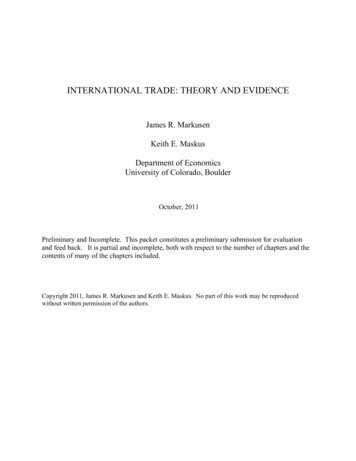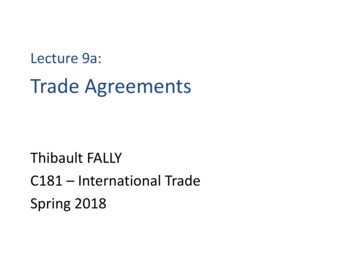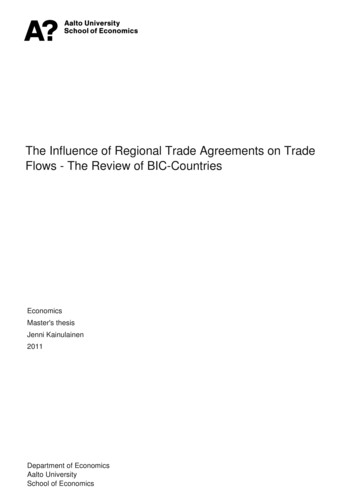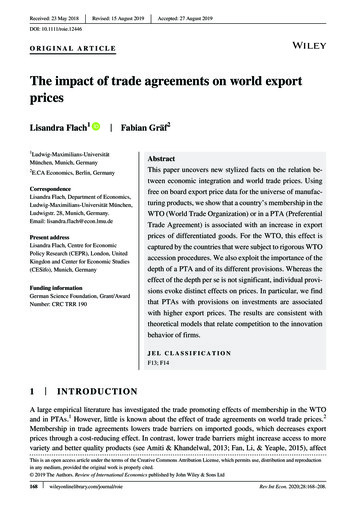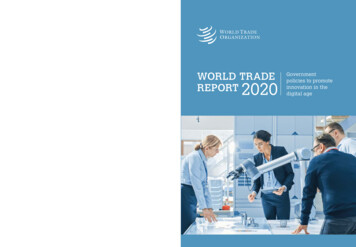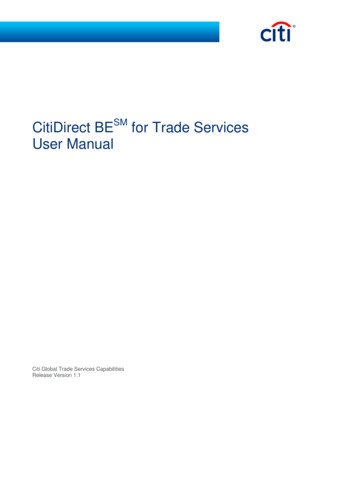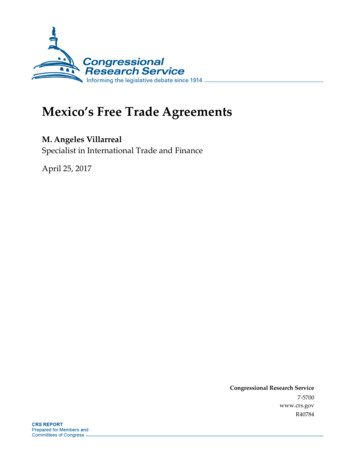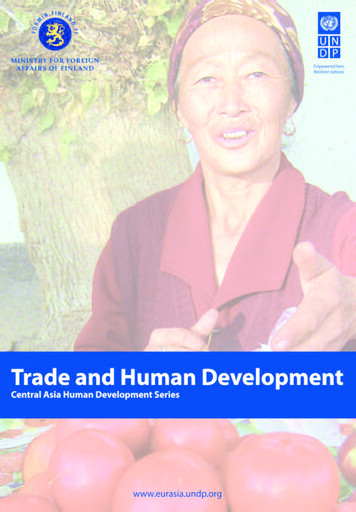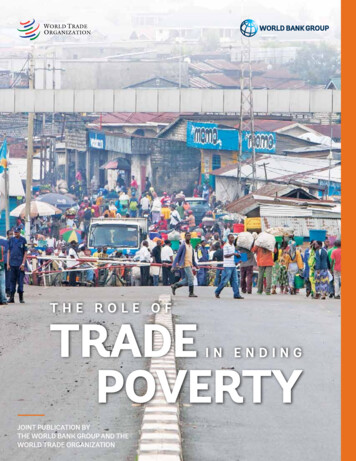
Transcription
THE ROLE OFTRADEPOVERTYIN ENDINGJOINT PUBLICATION BYTHE WORLD BANK GROUP AND THEWORLD TRADE ORGANIZATION
DisclaimerThe designations employed in this publication and the presentation of material therein do not implythe expression of any opinion whatsoever on the part of the World Bank, its Board of ExecutiveDirectors, or the governments they represent, or the World Trade Organization concerning the legalstatus of any country, area or territory or of its authorities, or concerning the delimitation of its frontiers.The responsibility for opinions expressed in this publication rests solely with their authors, andpublication does not constitute an endorsement by the World Bank or the World Trade Organization ofthe opinions expressed. Reference to names of firms and commercial products and processes doesnot imply their endorsement by the World Bank or the World Trade Organization, and any failure tomention a particular firm, commercial product or process is not a sign of disapproval.This volume is a co-publication of the World Bank and the World Trade Organization.Attribution—please cite the work as follows: World Bank Group and World Trade Organization, 2015.The Role of Trade in Ending Poverty. World Trade Organization: Geneva.Copyright 2015 World Trade OrganizationCover image: Goma/Rubavu border crossing between Rwanda and the Democratic Republic of theCongo (Photo: Simone D. McCourtie/World Bank)
CONTENTS3FOREWORD4ACKNOWLEDGEMENTS5ABBREVIATIONS AND ACRONYMS7EXECUTIVE SUMMARY12CHAPTER 1: Global growth, trade andpoverty: the macro links13The global economy15The poverty challenge19Trade and the poor: theory and evidence19Growth and macroeconomic stability21Impacts on households and markets21Impact on wages and employment24Impact on government revenue25264042CHAPTER 2: Constraints faced by the poor27Rural areas31Fragile and conflict-affected areas34Informality35Women, trade and poverty39Conclusion1Integrating markets and improvingthe enabling environment43Tariff and non-tariff measures45Infrastructure and trade facilitation46Access to trade-related technology and trade finance47Enabling environment48ConclusionCHAPTER 3: Policies to maximize thegains of trade opportunities for the poor,and minimize the risksRefining integration and mitigatingrisks to maximize positive effects for the poor48Refining integration to maximize gains for the poor53Understanding and managing risks54Understanding the links betweentrade and poverty through better data and analysis57WTO and World Bank Group supportfor trade as a means of poverty reduction59Conclusion: implementing astrengthened trade policy agenda for the poor62NOTES67REFERENCESThe Role of Trade in Ending Poverty
FOREWORDThis is a critical year in the world’s collaborative effort to end global poverty and boost the incomes of thepoorest. We will endorse the Sustainable Development Goals, develop a plan for financing for development,and reach for a landmark agreement to mitigate and adapt to climate change. If we are to end extreme povertyby 2030, we must do all we can in this final push to raise the incomes of the extreme poor. The Role of Trade inEnding Poverty makes the case for how trade can contribute to this ambitious goal.Advances we make this year to reduce global trade barriers and strengthen the global trading system wouldadd significant momentum to our efforts to end poverty. Our best opportunity to take these steps forward will bethe WTO Ministerial Conference in Nairobi this December, where participants will make a renewed push to finalizemultilateral trade negotiations in many areas. Though progress will be difficult, there is reason for optimism:The 2013 Ministerial Conference in Bali had a historic outcome, as parties signed the WTO’s Trade FacilitationAgreement and made important decisions, many of which will benefit Least-Developed Countries.To build on this momentum, we must address the trade costs that keep markets from being more fullyintegrated. Critical components will involve implementing the Trade Facilitation Agreement, advancing multilateralnegotiations, achieving further policy reforms, and delivering Aid for Trade from the World Bank Group, the WTOand other partners.In addition, policies to increase the contribution of trade to growth will need to be matched with a new effortto maximize the extreme poor’s gains from trade. This entails tackling key challenges confronting the poorest,including rural poverty, gender inequality, fragility and conflict, and the nature of the informal economy.The Role of Trade in Ending Poverty sets out a framework for action on these issues. Closer coordinationbetween the World Bank Group and the WTO, as well as partnerships with others in the international community,will be critical to our success. Although our two organizations have different mandates and memberships, they areunited in a common purpose to contribute to economic development and improve people’s lives around the world.At this critical juncture in history, we need to ensure that trade helps all, especially the poorest, as we strive toreach the goal of ending extreme poverty in a generation.Roberto AzevêdoJim Yong KimDirector-GeneralPresidentWorld Trade OrganizationWorld Bank Group3The Role of Trade in Ending Poverty
ACKNOWLEDGEMENTSThis publication has been prepared jointly by the staff of the World Bank Group (WBG) and World Trade Organization(WTO). Marcus Bartley Johns (WBG), Paul Brenton (WBG) and Roberta Piermartini (WTO) were the coordinators ofthe publication. The main authors of the various parts of the publication were Marcus Bartley Johns, Paul Brenton,Massimiliano Cali, Mombert Hoppe, and Roberta Piermartini. A number of other staff from the WBG and WTO madevaluable contributions, including Joan Apecu, Marc Auboin, Marc Bacchetta, Cosimo Beverelli, Michael Ferrantino,Christian Henn, Alexander Keck, Shaun Mann, Juan Marchetti, José-Antonio Monteiro, Gaurav Nayyar, Coleman Nee,Mikiko Olsen, Robert Teh, and Thomas Verbeet. The coordinators wish to acknowledge the helpful comments receivedat various stages of preparing the publication, including from Dobromir Christow, Diwakar Dixit, Selina Jackson, CharlesKunaka, Nora Neufeld, Ana Revenga, Bob Rijkers, Michael Roberts, Michele Ruta, Sebastian Saez, Carmine Soprano,Melvin Spreij, Gretchen Stanton, David Tinline, Alina Truhina, Tara Vishwanath, Christian Wolff, and Tim Yeend.The advice and suggestions of the peer reviewers (Julian Clarke, Vasco Molini, and Raju Singh) are gratefullyacknowledged.The preparation of the publication was carried out under the guidance of Robert Koopman at the WTO, and BillMaloney and Anabel González at the WBG.The coordinators would like to thank Paulette Planchette and Aakriti Mathur for their assistance in the preparation ofthe publication.Dissemination and communications aspects of the publication were managed by Kristina Nwazota and Julia Oliver.The production of the publication was managed by Anthony Martin and Helen Swain at the WTO, and Mayya Revzina andothers in the Office of the Publisher at the World Bank. Design and layout of the publication were undertaken by SteveFrancis and his team. The publication was edited by Bill Shaw.4
ABBREVIATIONS and ACRONYMSEIFEnhanced Integrated FrameworkFCSFragile and Conflict-Affected StatesGATSGeneral Agreement on Trade in ServicesGATTGeneral Agreement on Tariffs and TradeGDPGross Domestic ProductGVCGlobal Value ChainHIVHuman Immunodeficiency VirusICTInformation and Communication TechnologyLDCLeast-developed CountryOECDOrganization for Economic Co-operation and DevelopmentR&DResearch and DevelopmentSPSSanitary and Phytosanitary StandardsSMESmall and Medium-sized EnterprisesUNUnited NationsUNESCAPUnited Nations Economic and Social Commission for Asia and the PacificWTOWorld Trade Organization5The Role of Trade in Ending Poverty
This report offers five interrelated and complementaryareas of policy formaximizing the gainsof trade opportunitiesfor the poor.12345LOWER TRADE COSTSFOR DEEPERINTEGRATIONOF MARKETSIMPROVE THEENABLINGENVIRONMENTINTENSIFYTHE POVERTY IMPACTOF INTEGRATION POLICIESMANAGE ANDMITIGATE RISKSFACED BY THEEXTREME POORBETTER DATAAND ANALYSISTO IMPROVE POLICY6
EXECUTIVE SUMMARYA key message of this report isthe need to sustain efforts tokeep global trade open and todo more to lower trade costs,by further integrating markets.The expansion of international trade has been essentialto development and poverty reduction. Today’s economyis unquestionably global. Trade as a proportion of global GDPhas approximately doubled since 1975. Markets for goods andservices have become increasingly integrated through a fall intrade barriers, with technology helping drive trade costs lower. Buttrade is not an end in itself. People measure the value of trade bythe extent to which it delivers better livelihoods, through higherincomes, greater choice, and a more sustainable future, amongother benefits. For the extreme poor living on less than 1.25 aday, the central value of trade is its potential to help transform theirlives and those of their families. In this way, there is no doubt thatthe integration of global markets through trade openness has madea critical contribution to poverty reduction. The number of peopleof a wider approach that recognizes the specific constraintsliving in extreme poverty around the world has fallen by around onefacing the extreme poor — and for many, their disconnectionbillion since 1990. Without the growing participation of developingfrom markets — if they are to benefit from trade. Thiscountries in international trade, and sustained efforts to lowerincludes challenges facing women, the rural poor, thosebarriers to the integration of markets, it is hard to see how thisin the informal economy, and those in fragile and conflict-reduction could have been achieved.affected states. Thus, in order to have the greatest impacttoward ending poverty, trade policy must be made andTrade can continue to play a key role in poverty reduction.implemented in conjunction with other areas of policy. ThisIn 2011 (the most recent year for which comprehensive dataentails deeper cooperation across sectoral lines, governmentare available), around one billion people remained in extremeagencies, and a wider range of stakeholders.poverty — just under 15 percent of the world’s population. The3) The World Trade Organization and World Bank GroupWorld Bank Group has adopted the goal of reducing this figureto less than 3 percent by 2030, and the concept is prominent inhave made substantial contributions to trade and povertydiscussions underway this year on the post-2015 Sustainablereduction. However, a great deal more remains to be done toDevelopment Goals. This report, jointly written by the World Bankend poverty, and both institutions and other partners need toGroup and the World Trade Organization, explores how sustainedcontinually review their activities to support poverty reductionefforts to lower trade costs and integrate global markets canto ensure they remain relevant in an ever-changing world.maximize the gains for the extreme poor. It offers strategies onTrade can drive poverty reduction by boosting growth.how to support further integration of the poor into global tradeAlthough the drivers of poverty are multi-dimensional, the basicby lowering trade costs in a way that maximizes the gains andrequirement for sustained poverty reduction is economic growth.minimizes the risks, with a particular focus on the work of the WorldOpening up to trade increases a country’s GDP because it allowsTrade Organization and the World Bank Group.each country to use its resources more efficiently by specializingin the production of the goods and services that it can produceThis report has three key messages:more cheaply, while importing the others. Trade also affects long-1) A sustained effort to deepen economic integration andterm growth since it gives access to more advanced technologicalfurther lower trade costs is essential for ending poverty.inputs available in the global market and because it enhancesStrong growth in developing countries will be needed tothe incentives to innovate. Trade contributes directly to povertyachieve the end of poverty, and trade is a critical enabler ofreduction by opening up new employment opportunities, forgrowth, opening up opportunities for new and better workexample for agricultural producers, with the expansion of exportfor the poor. Although great progress has been made insectors, and by bringing about structural changes in the economyreducing trade costs and integrating low-income countriesthat increase employment of low-skilled, poor workers in theinto the global economy, more needs to be done.informal sector. Trade also provides better access to externalmarkets for the goods that the poor produce. Understanding these2) Lowering tariffs and non-tariff barriers between countries arechannels helps us trace through the impact that trade can have onessential elements of this agenda, but this must form partthe extreme poor.7The Role of Trade in Ending Poverty
The increasingly integrated global economy has beenis evidence to suggest that it will become even harder for overalla critical factor behind the poverty reduction achieved sogrowth to be translated into income gains for the poor. Extremefar. And integration will be just as — if not more — importantpoverty is becoming concentrated in countries and regions whereon the path to 2030. A key message of this report is the need topoverty reduction seems to be less responsive to overall growth.sustain efforts to keep global trade open and to do more to lowerThe extreme poor face numerous constraints that limittrade costs, by further integrating markets. Reducing trade coststheir capacity to benefit from wider economic gains. In thisin countries where the poor live may not just oil the engine ofcontext, trade integration is important not only because of the boosteconomic growth, but also can increase the competitiveness ofto growth it can provide, but also because there is room for it bethe goods and services traded by the poor and lower the costsexecuted in ways that more effectively overcome the constraintsof key inputs in production, such as fertilizers for poor farmers.faced by the extreme poor. A novel feature of this report is the linkThe inverse relationship between trade costs and income — thedrawn between these challenges facing people living in extremepoorer countries are, the higher the trade costs they face —poverty and their capacity to benefit from trade, as a key driverunderlines the need to do more on this front. Lowering trade costsof growth. The report describes four leading characteristics of theis particularly important for countries seeking to take advantagepoor that have a particularly strong impact on their capacity toof the fragmentation of production through global value chains,extract the full potential benefits of trade: rural poverty; fragility andwhich offer new opportunities to generate growth and income gainsconflict; informality; and gender.through trade.Each of these four characteristics shapes the environmentYet growth alone may not be enough to achieve the end ofin which the extreme poor live, and constrains them frompoverty by 2030. Based on recent World Bank projections of likelybenefiting from trade opportunities. Poverty in many partsglobal growth to 2030, growth is unlikely to be high enough acrossof the world — especially in Sub-Saharan Africa, where theall developing countries to reduce poverty to the level sought bychallenge of ending extreme poverty is greatest — is a strikingly2030. Developing countries would have to grow at an average of 4rural phenomenon. For the rural poor, trade and internal marketpercent each year — even higher than the growth rate of the 2000sbarriers in agriculture present real challenges to benefiting fromand much higher than that of the 1980s and 1990s. Even withtrade opportunities. More than half of the extreme poor live insustained growth, as poverty continues to decline globally, therefragile and conflict-affected areas (often dominated by revenuesfrom high value minerals and other natural resources) and are lesslikely to be able to benefit from trade opportunities, even thoughexport diversification by providing alternative livelihoods can be anessential pathway out of conflict. Poverty and informality often gohand in hand. Informal sector workers and the micro-enterprisesthat dominate the informal economy face particular challenges, andare vulnerable to sudden economic shocks. Finally, women areoften at the forefront of poverty reduction, and trade has broughtparticular benefits for women in terms of jobs and empowerment.However, women face specific constraints, both within and outsidethe household, which can make it difficult to participate in and gainfrom trade opportunities.The risks faced by the poor also affect their capacity tobenefit from trade opportunities. Major risks faced by the pooracross each of the four dimensions of poverty include economicshifts, labor market adjustments, and vulnerability to weatherevents and to climate change. At the same time, the poor often lackaccess to the instruments and support necessary to mitigate theserisks — things people in advanced countries take for granted, suchas insurance and social security. When poor people face risks,they may be unable to adopt strategies to make the most of trade8
Executive Summaryopportunities, even where these strategies would be beneficial. Foron lowering tariffs and non-tariff barriers between countries areexample, the risks faced by subsistence farmers are at least partlyessential elements, but they must form part of a wider approach.responsible for their inability to invest in higher quality inputs likeOnly a holistic approach, which also incorporates a variety ofseeds and fertilizers, which could help them take full advantagespecific localized measures, can begin to deliver the gains requiredof trade opportunities. Similarly, a lack of access to financeto end global poverty. Although countries are the basic “buildingoften limits the capacity of informal microenterprises to invest inblocks” of international trade policy, the challenges faced by theways that would allow them to offset risks. Understanding andpoor vary greatly within national borders, and across borders.addressing these risks is important to ensure that trade deliversFor this reason approaches that focus on lowering trade costsmaximum benefits to the poor.between countries will need to be complemented by efforts to tacklechallenges faced by the poor within and across national borders.While the challenges and risks facing the extreme poor areThis underlines the importance of the various programs that theconsiderable, the opportunities are great. Cross-border tradeWorld Trade Organization and World Bank Group have in place toenhances the income of agricultural producers and traders in pooraddress these challenges, and of further efforts in this regard.countries. Trade has contributed to women moving out of agricultureThis report offers five inter-related and complementaryinto manufacturing and especially services, and this has broughtwith it higher incomes and more formal employment. Trade canareas of policy that can be considered by countries and thealso help to devise pathways out of conflict. Pursuing strategies forinternational community in implementing this approach:economic integration in ways that address the challenges faced by Lowering trade costs for deeper integration of markets.the extreme poor can help maximize the gains from trade.Trade facilitation — including implementation of the WTOThe greatest impact on poverty reduction will come throughTrade Facilitation Agreement — as well as tackling othera coherent approach that lowers trade costs in ways thatpolicy and infrastructure barriers to goods and services trademaximizes the gains for the extreme poor. Policies that focusare critical to growth and poverty reduction.9The Role of Trade in Ending Poverty
10
Executive Summary Improving the enabling environment. Trade openness itselflevel, complementing unilateral opening and regional cooperation,and lowering trade costs is essential for delivering gainsand helping developing and least developed countries to integratefor the poor. A range of complementary policies helpsinto the trading system remain as relevant today as ever. Themaximize the gains of openness for the poor — includingrules-based global trading system has been essential in reducingpolicies related to human and physical capital, access tothe risks faced by the poor from opaque and unpredictable tradefinance, governance and institutions and macroeconomicpolicies — both in terms of access to markets for the products theystability. Strengthening the enabling environment can beproduce and by creating a stable trading environment to supportdone through innovative policy frameworks that improvejob-creating investment, both domestic and foreign, in trade-consultation with the poor, and target their needs morerelated activities. Updating the World Trade Organization’s rules,carefully. To achieve this will require deeper cooperationmarket access commitments and flexibilities through a successfulacross sectors, better coordination across governmentconclusion of the current round of Doha negotiations will expandministries and agencies and that a wider range ofthe opportunities for developing countries to benefit from inclusionstakeholders work effectively together.in the global trading system and foster development.The World Trade Organization also plays a key role in Intensifying the poverty impact of integration policies.Bringing a greater focus on tackling remoteness fromsupporting trade facilitation. The need to support countries inmarkets at the sub-national level, and facilitating themaking the most of trade opportunities is recognised in the Tradeactivities of poor and small traders, can help improve gainsFacilitation Agreement, which states that assistance and supportfor the poor, especially in rural areas. This also entailsmust be granted to help developing countries achieve the capacityreforms to tackle costs generated by a lack of competition,necessary to implement its provisions. Various efforts are nowand other sources of domestic costs. Promoting greaterunderway, including by the World Bank Group, to ensure that thisinclusiveness of women, and targeting the challenges theycommitment is delivered. Ratification and implementation of theface as distinct from men, is central to efforts to intensify theTrade Facilitation Agreement has the potential to deliver significantpoverty impact of integration policies.reductions in trade costs, especially in the poorest countries.Recognising the particular constraints faced by the poor, including Managing and mitigating risks faced by the poor. More focussmall-scale traders, and focusing on connecting the extreme pooris needed on managing the existing risks that poor peopleto markets would maximize the impact of the Agreement on povertyface that limit them from benefiting from trade opportunitiesreduction.when they arise. Effective risk management can be aThe Aid for Trade Initiative, convened by the World Tradepowerful instrument for development, through building poorpeople’s resilience to the effects of adverse events andOrganization, has helped mobilise significant additionalalso by allowing them to take advantage of opportunities forresources for trade-related assistance, and could moreimprovement. Addressing any potential risks to livelihoodsclosely monitor the impacts of trade integration on povertyfor the poor through trade-related adjustments is alsoreduction. As the leading multilateral donor of Aid for Trade, theimportant.World Bank Group has a key role to play through its financingcapacity, widespread country presence, capacity to undertake and Improving data and analysis to inform policy. The gapswidely disseminate relevant research, knowledge and analyticalin understanding of poverty, the nature of the informalexpertise, and multi-sectoral capacity and reach. The Bank Groupeconomy, the participation of women in trade, and of theis increasingly focusing on fragile and conflict states, and thetrade-related constraints in general that many countries faceimportance of agricultural development in raising incomes in ruralcontinue to be large. Better data is required for the designareas. Improving the tools to monitor the impact of Aid for Tradeand implementation of effective policies to maximize theand integrating effective trade indicators into broader monitoringpoverty reduction gains from trade.systems of poverty reduction and progress in fragile states is animportant area of on-going and future work for the Bank Group.The World Trade Organization plays a critical role inBoth institutions have a critical role to play in implementing theunderpinning an open and inclusive global trading system.agenda set out in this report.The key goals of pursuing further openness at the multilateral11The Role of Trade in Ending Poverty
112
Chapter 1GLOBAL GROWTH, TRADEAND POVERTY: the macro linksThe global economyThe relationship between economic growth, poverty reduction,and trade is not a simple one. Although great progress has beenToday’s economy is a global one — trade as a share of globalmade in reducing the number of people living in extreme poverty,GDP has grown massively, despite recent weakness, alongdue in large part to the rapidly growing participation of developingwith FDI. Since 1950 the share of world GDP made up by tradecountries in the global economy, nearly one billion people still liveand the volume of world trade have increased dramatically: globalon less than 1.25 per day. What will it take to end extreme povertymerchandise trade in 2014 was 18.9 trillion, up from 3.5 trillion inby 2030, which is the target date for the World Bank Group’s1990.2 Flows of investment have increased by even greater levels.goal, as well as the end date for the next set of United Nations1Tariffs have fallen steadily since the end of the Second Worlddevelopment targets? What role will trade openness play in theWar, along with progressive liberalization of capital controls, andnext phase of poverty reduction?greater connectivity through new technology in transportation andcommunications.Exploring these questions involves an understanding ofthe nature of the global economy and the structure of globalThis globalization has created new opportunities forpoverty today. In addition, it requires understanding the theoryeconomic growth, development and poverty reduction.and evidence of the main links between trade, economic growth,The rapid growth of the global economy is a relatively recentand poverty reduction and how these are changing in an evolvingphenomenon. Its expansion built up speed during the technologicalglobal economy.innovations since the Industrial Revolution, which allowed forthe more productive use of existing endowments of economicThis chapter shows that extreme poverty is becomingincreasingly concentrated in Sub-Saharan Africa and Southassets. The even faster growth of the last century is due largely toAsia, although pockets of extreme poverty persist in othertechnological innovations in communications and transportation,regions. The structure of the economies of countries in theseregions, especially in Africa, suggests that current growth trendswill not deliver the poverty reduction to eliminate extreme povertyby 2030. The chapter concludes, therefore, that we need to identifythe key characteristics of the poor in these countries to developways in which trade-driven growth can be more inclusive.The key characteristics that we have identified as being ofrelevance to the impact of trade on poverty are: the extremepoor mainly live in rural areas, many earn their livelihoods inthe informal sector, the majority lives in a fragile and conflictaffected state and women face particular challenges inalleviating poverty. These characteristics are all associated withthe poor facing substantial constraints to trade and higher risks intheir everyday lives that limit their capacity to adopt strategies thatwould allow them to raise incomes through trade. The report thenasks what needs to be done to first identify and then reduce thebarriers to new opportunities that trade can bring to the extremepoor and what can be done to address the high risks they face.13The Role of Trade in Ending Poverty
as well as the progressive lowering of barriers to global tradeto the WTO in 2001, China’s simple average tariff fell from about 40and finance.3 This helps explain the strong correlation betweenpercent in 1985 to under 10 percent today.5 The growing size andincreased exports of goods and services as a share of global GDP,increased openness of large developing markets has provided newand the steady decline in the number of global poor (Figure 1.1).export opportunities for many other developing countries and hasbeen an important factor driving growth.In this most recent period, developing countries haveexperienced high and sustained growth while participation inThe emergence of global value chains has been anthe global economy has increased rapidly. Developing countryimportant driver of developing country participation intotal trade as a share of GDP has doubled since 1985. Since 2000the global economy. Countries no longer need to developalone, the developing country share of world trade increased fromcompetitiveness in whole industries to be able to trade. Declining33 percent to 48 percent. China is now the world’s largest exporter,transportation and communications costs, along with improvedwith a number of other developing countries in the top twentytechnology, have made it easier for firms in d
other benefits. For the extreme poor living on less than 1.25 a day, the central value of trade is its potential to help transform their lives and those of their families. In this way, there is no doubt that the integration of global markets through trade openness has made a critica

